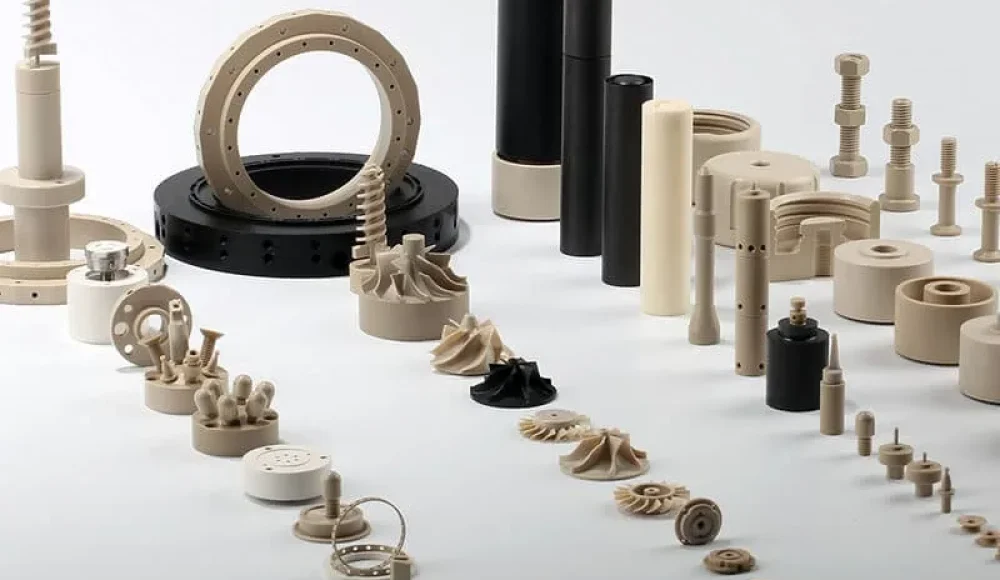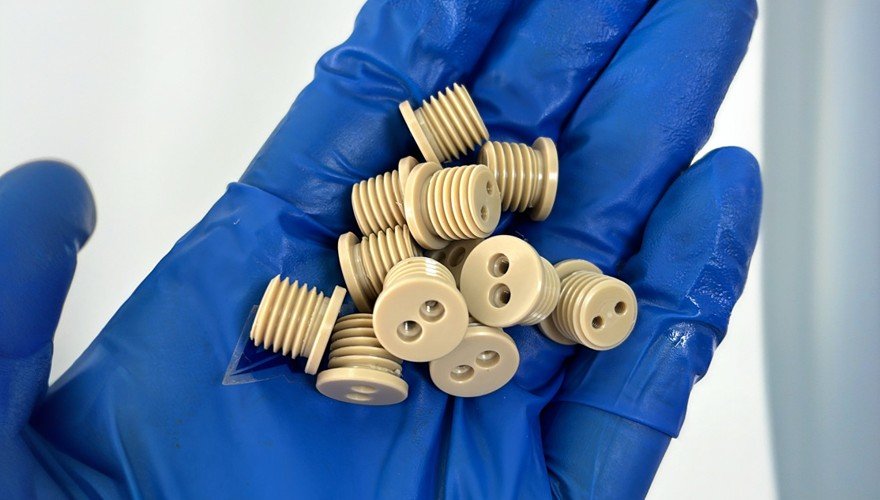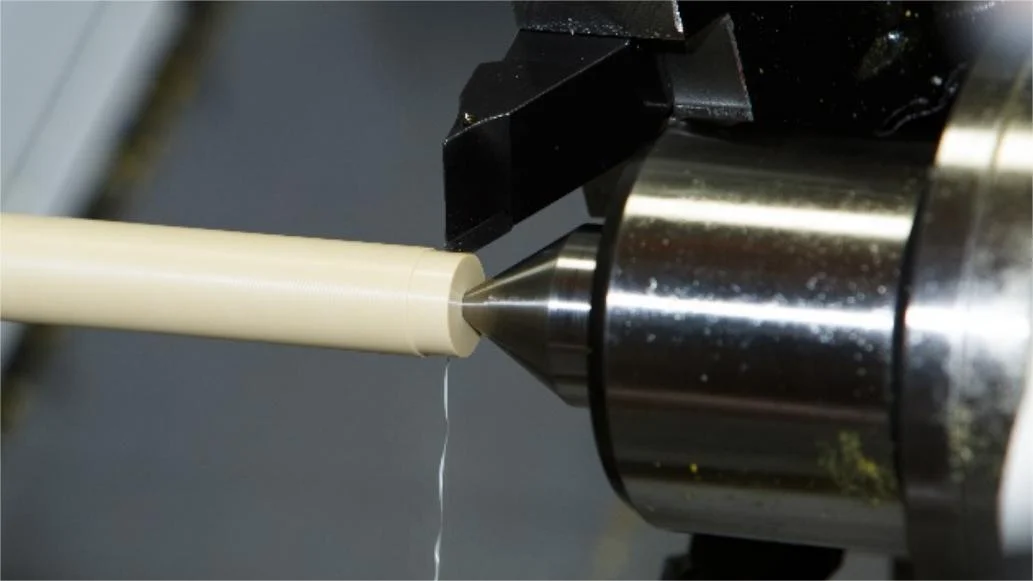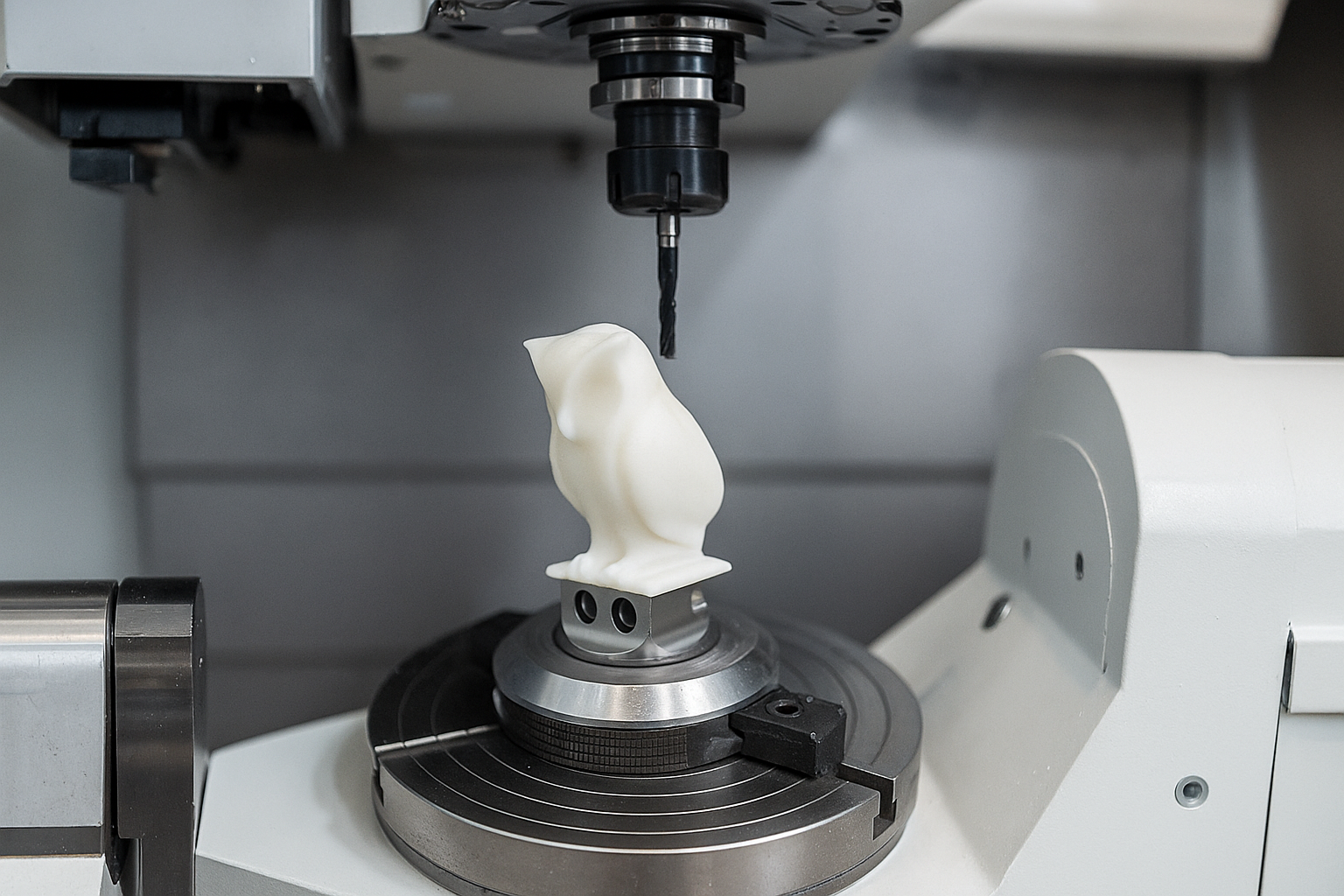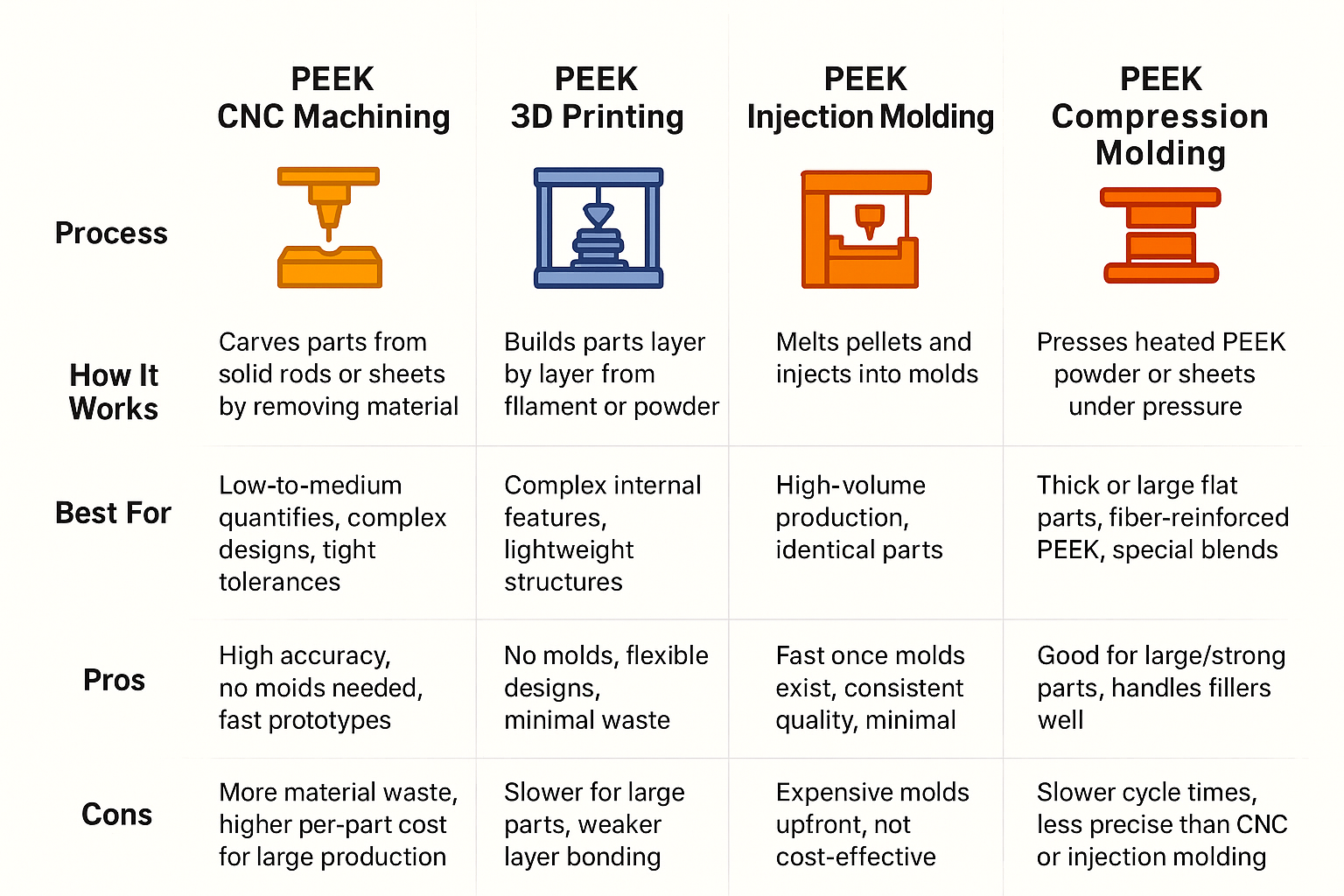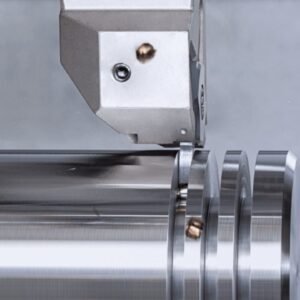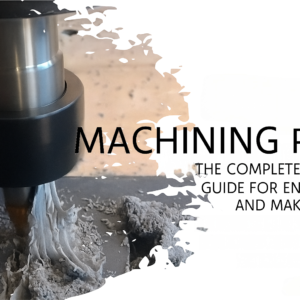Ether de poliéter cetona (OLHADINHA) is one of the most versatile high-performance thermoplastics used in modern engineering. Known for its exceptional strength, resistência química, e estabilidade térmica, PEEK is widely chosen for demanding applications in aerospace, dispositivos médicos, and high-load industrial equipment.
Although PEEK machines relatively well compared to other engineering plastics, it has unique characteristics that require careful process planning. Without the right techniques, issues such as thermal cracking, dimensional instability, or poor surface finish can occur. This article explores what makes PEEK special, its benefits and challenges in machining, practical tips for better results, and key industrial applications.
What is PEEK (Ether de poliéter cetona)?
PEEK is a semi-crystalline thermoplastic belonging to the polyaryletherketone (PAEK) family. It offers a balance of mechanical performance, Estabilidade química, and thermal endurance that few other plastics can match.
Propriedades principais
Alta resistência & Resistência ao desgaste – Comparable to some metals while retaining the benefits of a lightweight polymer.
Alto ponto de fusão – ~343 °C (649 °F), enabling use in continuous service up to 250 °C (482 °F).
Excellent Chemical Resistance – Unaffected by most organic and inorganic chemicals.
Low Moisture Absorption – Maintains dimensional stability in humid or wet environments.
Radiation Resistance – Withstands gamma and X-ray exposure without significant degradation.
Biocompatibilidade – Certain medical-grade PEEK complies with ISO 10993 and USP Class VI standards.
Available Forms
Granules – For injection molding and extrusion.
Filament – For additive manufacturing.
Rods, Barras, and Plates – Common starting shapes for CNC machining.
PEEK is available in unfilled grades for general applications, e reinforced grades (glass fiber, fibra de carbono, or PTFE-filled) for enhanced wear, força, or thermal properties.
Advantages of Machining PEEK
Super Strong, Even Under Stress
PEEK is tough. It holds its shape and strength even when it’s under pressure or carrying heavy loads, which makes it perfect for parts that need to work hard every day.
Can Handle the Heat
While many plastics get soft or warp when things get hot, PEEK can handle continuous temperatures up to around 250°C (480°F) without breaking a sweat.
Resists Chemicals Like a Pro
Oils, combustíveis, acids — PEEK doesn’t care. It’s resistant to many harsh chemicals, so it stays reliable in environments that would damage other materials.
Lightweight Yet Durable
You get the strength of metal but with a fraction of the weight. This is why aerospace and automotive industries love it — lighter parts mean better fuel efficiency.
Excellent Wear Resistance
Parts made from machined PEEK last a long time because it can handle friction without wearing down quickly.
Easy to Machine Into Complex Shapes
Even though it’s tough, PEEK machines well with the right tools, so you can create very detailed and precise parts without major headaches.
Biocompatible and Safe for Medical Use
Medical-grade PEEK is safe to use inside the human body, which is why it’s often used in implants and surgical tools.
Limitations of PEEK Machining
It’s Not the Cheapest Option
PEEK is pricey compared to many other plastics. If you’re making a lot of parts or working on a budget-sensitive project, material cost can be a big factor.
Needs Sharp Tools and Careful Machining
Even though PEEK machines well, it’s still tough on cutting tools. You’ll need sharp, high-quality tools and proper speeds/feeds to get a smooth finish without damaging the part.
Heat Buildup Can Be a Problem
PEEK can handle high temperatures, but during machining, too much localized heat from the cutting tool can cause melting, deformação, or surface defects. Good cooling is essential.
Limited Color Options
Most PEEK is naturally beige or tan. If you need colorful parts for design or branding, you might have to consider coatings, dyes, or other plastics.
Not Always the Best Choice for Very Soft or Flexible Parts
PEEK is rigid and strong, which is great for structural parts, but not ideal if you need flexibility or cushioning.
Long Lead Times for Special Grades
Standard PEEK is usually easy to find, but special grades (like carbon-filled or medical-grade) might take longer to source, slowing down production.
How Do You Machine PEEK?
Fresagem CNC
Great for creating flat surfaces, slots, bolsos, e formas 3D complexas. Usando sharp carbide tools and high spindle speeds helps keep the edges clean and prevents melting.
Perfect for round parts like bushings, varas, and seals. Turning PEEK works well with light cuts and steady feed rates to avoid heat buildup and maintain tight tolerances.
Perfuração
You can drill PEEK cleanly using standard twist drills, mas chip evacuation is key. If chips aren’t cleared quickly, heat can build up and cause surface damage.
Tapping and Threading
Internal and external threads can be cut in PEEK with proper tool lubrication. This is often used for mechanical fasteners or custom fittings.
Acabamento superficial
Após a usinagem, PEEK parts can be polished, Merda cata, or coated depending on the application — whether you want a functional finish or a sleek look.
What Surface Finishes Can You Get When CNC Machining PEEK?
Typical CNC-Machined Finish
Most PEEK parts straight off the CNC have a smooth, acabamento fosco. This is fine for mechanical components where looks aren’t the priority. Surface roughness here is usually around Ra 1.6–3.2 μm.
Fine Machining for a Better Finish
Usando sharp carbide tools, slower feed rates, and light cuts, you can improve the surface to about Ra 0.8–1.6 μm, giving it a cleaner, more refined look.
Polishing for High-End Applications
If you need a glossy or near-mirror surface — for example, in medical implants or visible aerospace parts — PEEK can be polished after machining. Polishing can bring surface roughness down to Ra 0.2–0.4 μm.
Other Surface Treatments
Bedia de contas for a uniform, textura fosca
Revestimentos for extra wear or chemical resistance
Laser marking for permanent labels without damaging the surface
What is the Tolerance of PEEK in Machining?
Typical Tolerances:
Na maioria dos casos, you can hold tolerances of ±0,05 mm (±0.002 in) without much trouble. With fine-tuned equipment, you can even go tighter, down to ±0,025 mm (± 0,001 in).
Factors That Affect Tolerance:
Acúmulo de calor – Too much heat can cause slight expansion, affecting precision.
Moisture – PEEK absorbs some water over time, which can change dimensions. Drying it first helps.
Desgaste da ferramenta – Dull tools reduce accuracy and surface finish.
Machine stability – A rigid, well-calibrated CNC machine is key for high-precision work.
Applications of Machined PEEK
Peças Aeroespaciais
PEEK can handle high stress, vibração, and extreme temperatures, making it perfect for lightweight aircraft components like brackets, grampos, vedações, and insulation parts.
Dispositivos médicos
Because it’s biocompatible (safe for the human body), PEEK is used for surgical tools, dental parts, spinal implants, and other medical equipment that needs to be strong, luz, and sterilizable.
Componentes Automotivos
In cars, PEEK is used for high-performance gears, buchas, and seals that can stand up to heat from engines and friction from moving parts.
Electronics and Electrical Equipment
PEEK is an excellent electrical insulator, so it’s used in connectors, circuit board supports, and insulation components for high-voltage systems.
Óleo, Gás, and Energy Industry
PEEK resists harsh chemicals, alta pressão, and extreme heat — which is why it’s used in valve seats, componentes da bomba, and seals for drilling equipment.
Maquinaria industrial
In manufacturing plants, PEEK’s wear resistance makes it a great choice for bearings, rolos, and parts that face constant mechanical stress.
Tips for Machining PEEK
Use Sharp, High-Quality Tools
PEEK is abrasive, so dull tools will wear out fast and leave poor surfaces. Carbide or diamond-coated tools last longer and cut cleaner.
Control the Heat
PEEK can soften if it gets too hot during machining. Use proper coolant or air blasts to keep temperatures down and prevent warping.
Don’t Rush the Feed Rate
Going too fast can overheat the material, while going too slow can cause tool rubbing. Aim for a balanced speed and feed for smooth cutting.
Clamp the Material Securely
PEEK is tough but not brittle — still, vibrations can ruin accuracy. Use firm, even clamping to keep your part stable during the cut.
Pre-Dry Before Machining (Se necessário)
PEEK can absorb moisture over time, which might cause bubbles or rough spots during machining. Dry it in an oven before cutting for best results.
Finish With Care
If you need a super-smooth surface, consider fine polishing or grinding after machining. PEEK can achieve an almost glossy finish with the right touch.
Watch for Chip Build-Up
PEEK chips can be stringy and may wrap around tools. Use proper chip removal methods so your cutting edges stay clean.
Comparing Manufacturing Methods for PEEK
Conclusão
PEEK’s unique combination of strength, resistência química, and biocompatibility makes it a go-to material for industries where failure is not an option. By understanding its machining challenges—especially heat management and stress relief—manufacturers can produce high-quality components with excellent performance and longevity.
Choosing the right manufacturing method depends on your production goals: CNC machining for precision and versatility, 3D printing for design complexity, and injection molding for mass production. With the right process strategy, PEEK can deliver outstanding results across both industrial and medical fields.

